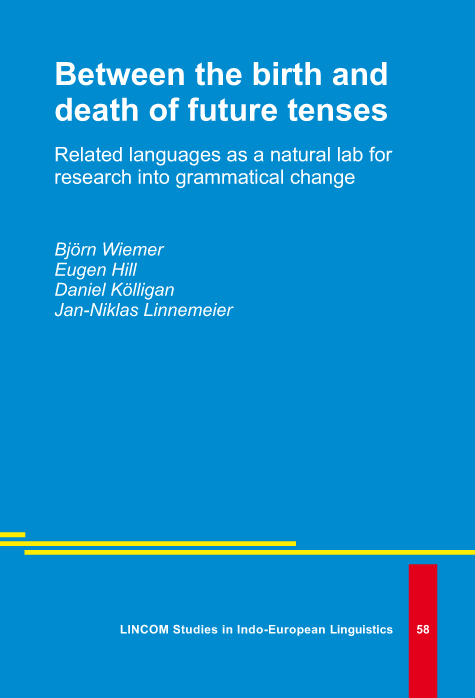New Book Release
This monograph is the first attempt at a comprehensive dynamic description of future tenses that have been attested in a whole language family, namely the Indo-European one. In general, future tenses are known as a non-obligatory feature of grammar which are repeatedly lost and acquired anew. Together with this, futures are particularly prone to variation, displaying a variety of additional (morpho)syntactic and functional properties. The authors intend to identify factors which trigger and/or facilitate the rise and subsequent evolution of different types of futures.
To this end, this investigation is sketched on the basis of the Indo-European language family, so that the rise and evolution of futures are comprehensively investigated in a range of languages with similar typological characteristics and of identical genealogical provenance. Their ultimate common ancestor did not have any dedicated future tense, and the different branches of this family embrace numerous closely related and therefore originally very similar languages spoken in Europe and Asia. The Indo-European language family is thus used a kind of natural laboratory, providing dynamic data on futures in diverging language systems.
1. Introduction
2. Future tense in the dynamics of grammar
2.1. (In)Stability and the relation between futures
2.1.1. Trait vs inheritance stability and polygenesis
2.1.2. A note on replacement
2.2. Diachronic typology of futures: emergence, entrenchment and loss
2.2.1. Small-scale changes and distributions
2.2.2. Hypoanalysis
2.2.3. Source constructions, pathways, and restrictions
2.2.4. Factors and their counterbalance: triggers and blockers
3. The Indo-European languages as a natural lab
3.1. Parallels in dialectology
3.2. Questions put to the natural lab
3.3. On the Indo-European family.
4. Survey of particular (groups of) languages
4.1. Futures suceeding PIE morphological structures
4.1.1. Preliminaries and basic notions on PIE verb morphology
4.1.2. The subjunctive-based futures in the IE daughter languages
4.1.3. The s-modal futures in the IE daughter languages
4.1.3.1. The reduplicated se-formation in Indo-Iranian and Insular Celtic
4.1.3.2. The (non-reduplicated) se-formation of Insular Celtic and Ancient Greek
4.1.3.3. The s e-formation of Indo-Iranian, Balto-Slavic and Continental Celtic
4.1.3.4. The s-formation of Balto-Slavic and Sabellic Italic
4.1.3.5. Unclear cases
4.1.3.6. The system of s-modals in PIE
4.1.3.7. Summary on PIE s-modals
4.1.4. Summary on futures succeeding PIE morphological structures
4.2. The east
4.2.1. Indo-Aryan
4.2.2. Iranian
4.2.2.1. From Middle to modern Iranian
4.2.2.2. Persian
4.2.2.3. Ossetic
4.2.3. Nuristani
4.2.4. Armenian
4.2.4.1. Classical Armenian
4.2.4.2. Modern Eastern Armenian and Modern Western Armenian
4.2.4.3. The period in between
4.3. Isolates on the Balkans
4.3.1. Greek
4.3.2. Albanian
4.4. Baltic: East vs West
4.4.1. Old Prussian
4.4.2. East Baltic
4.5. Slavic
4.5.1. Overt future marking
4.5.1.1. Inchoative *bǫd-.
4.5.1.2. Inchoative, ingressive or change of position?: stati
4.5.1.3. Ingressive -čęti > -čati + prefixes (za-, po-, u-, na-)
4.5.1.4. Inceptive *jęti > jati ‘take, seize’ > ‘begin’
4.5.1.5. Slovak ísť: from prospective to andative future
4.5.1.6. From volition to future: xotěti ‘want’
4.5.1.7. From obligation to future: iměti / imati ‘have (to)’
4.5.2. Issues of chronology
4.6. Germanic
4.6.1. Devolitional future
4.6.2. De-obligational future
4.6.3. Future grams from verbs of movement
4.6.4. Future from inchoative copular verb
4.6.5. Univerbation with an adverb
4.7. Celtic
4.7.1. Hypoanalysis present > future
4.7.2. Periphrastic constructions
4.8. Romance
4.8.1. HAVE-based futures
4.8.2. GO-based futures
4.8.3. Other futures, mainly those based on modal constructions
4.8.4. Romanian
5. Tying up the threads
5.1. The role of triggers and blockers
5.1.1. Defectivity in the conjugation system as forestage of death or consolidation of futures
5.1.1.1. Consequences of distributional defectivity in Celtic
5.1.1.2. Consequences of distributional defectivity in other IE languages
5.1.2. Language contact as a trigger of the development, or consolidation, of futures
5.1.3. Conceptual triggers
5.2. Areal patterns
5.3. Patterns concerning grammaticalization vs hypoanalysis
5.4. Time stability
5.5. What comes after a future?
5.6. In conclusion: quest for a database
Abbreviations: Glossing
Abbreviations: Languages
References
LINCOM
<contact
 lincom.eu>
lincom.eu>











